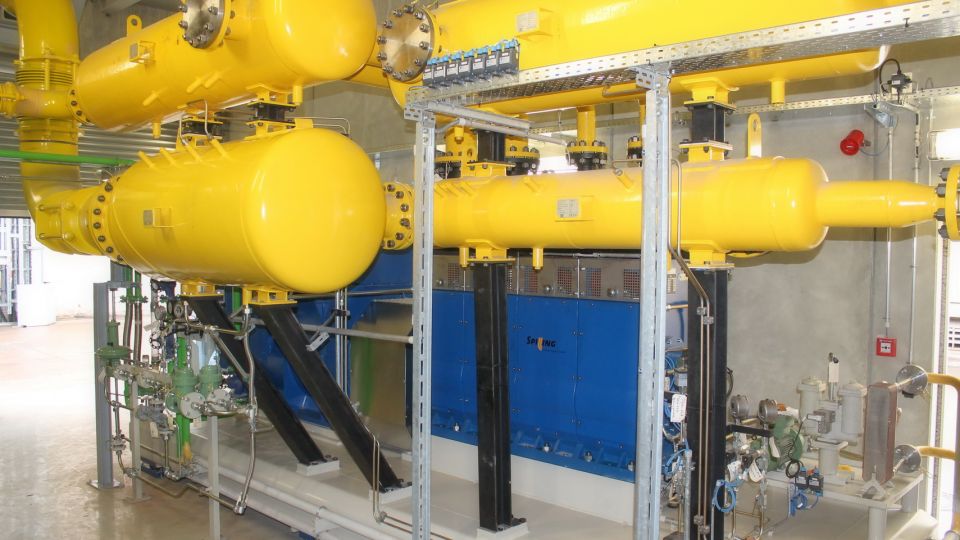Natural gas suppliers work at high pressure for transport
A process that is flexible enough to adapt optimally to the fluctuating gas purchases of municipal utilities, that saves costs, reduces CO2 emissions and can also contribute to improving the company's image. Thanks to new materials for seals, state-of-the-art control technology and digitalization, the Spilling gas expansion engine still provides municipal utilities today with a cutting-edge tool for highly efficient power generation.
And this is how gas expansion works: The natural gas that the municipal utilities distribute in their networks is compressed to high pressure at the upstream supplier. This is the only way the gas can be transported over long distances. For distribution in the networks of the municipal utilities, however, a much lower pressure is required, so that the gas pressure in gas transfer stations is regulated to the desired pressure level. In many cases, the available excess pressure energy is simply dissipated. This is a pity, because when a gas expansion motor is used, the pressure gradient between natural gas transport networks and distribution systems (or consumers) is used to extract mechanical or electrical power. This type of power plant offers maximum efficiency.
Proven technology has been in use in many places for decades
A company in Northern Germany has been using this method successfully since 1988. The plant produces approximately 4800 Megawatt hours of electricity annually. In terms of figures, this amount is sufficient to supply 1200 four-person households with electricity each year. With this process alone, the municipal utilities contribute to an annual reduction of around 2500 tons of CO2.
Thanks to polymer seals, oil injection is no longer required
The machine mentioned above has been running for over 30 years without any major disruptions and has now been modernised once again. In the past, a little oil had to be added to the gas to lubricate the cylinders, but now it works oil-free thanks to robust new polymer seals. In addition, the control technology has been modernized and is now also state of the art again.
Some companies are achieving completely CO2-free power generation
However, the process does not work entirely without additional energy input. Gas cools down considerably during the expansion in a power engine. To prevent icing, the gas must therefore be preheated before the pressure is reduced. Even if the heat for this came from a conventional gas boiler, over 90 percent of the additional thermal energy required for the gas expander would be converted into electricity. An extremely high overall efficiency. The municipal utilities of the North German city have solved the gas preheating problem even more elegantly: there, waste heat from the combined heat and power unit (CHP) on the company´s premises is used to preheat the gas. Overall, the combination of gas expansion engine and CHP unit achieves highly efficient power generation with significantly lower CO2 emissions than in the conventional German power mix. If waste heat is available for gas preheating that is otherwise not usable anyway, as is often the case in industrial applications, this even results in completely CO2-free power generation.
| Sample characteristic data for gas expansion from 40 to 8 barg with a maximum gas flow rate of 30,000 Nm3/h | ||
| Electrical power output of gas expansion motor, max. | 915 | kW |
| Additional heat requirement compared to conventional gas pressure reduction | 950 | kW |
| Assumed hours of full use | 5,250 | h/year |
| Investment Costs | 1,840,000 | Euro |
| gas expansion motor with accessories: | 940,000 | Euro |
| periphery (piping, wiring, heat-exchanger for gas preheating, other fittings, building, external connections etc.): |
1,000,000 | Euro |
| Total annual savings | 343,400 | Euro/year |
| avoided electricity procurement costs:* | 528.,00 | Euro/year |
| additional heating costs for gas preheating:* | ./.125,000 | Euro/year |
| maintenance costs: | ./. 60,000 | Euro/year |
| Avoided CO2 Emissions of Gas Expansion Motor + CHP | 2,530 | tons/year |
| avoided CO2 emissions due to electricity from GE engine + CHP compared to conventional power generation:** |
4,630 | tons/year |
| total CO2 emissions from CHP units:** | 2,100 | tons/year |
| Total Annual Savings | 343,000 | Euro/year |
| Investment Costs | 1,940,000 | Euro |
| Payback Period | 5.7 | years |
| Base: *Costs: CHP waste heat: 25 Euro/MWh; electricity: 110 Euro/MWh **CO2 emissions: natural gas: 0.20 kg/kWh; electricity: 0.50 kg/kWh Assumption CHP with 850 kW(el), 950 kW(th) and 2,000 kW gas demand (each at full load) |
